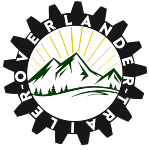When it comes to building an overlander trailer, it is obviously important to start with a good foundation so frame selection is a critical first step.
There are many different routes you can go. If you are a welder, or know a welder, you could build a frame that way. If you’re like us, and don’t really have access to a welder, buying a trailer frame is the next best solution.
I did a quite a bit of research on this and found that some people build off already assemble frames like those you can get at Lowes or Home Depot, however there seemed to be some concern that those trailer frames need to be beefed up a bit with reinforcement to be able to handle the potential twisting in off road situations.
Through my research, the bolt together frame options from shops like Northern Tool and Harbor Freight seemed to be the best way to go, which is what we decided on.
While this type of frame is well rated, there are a few things to be aware of.
Trailer Size
Really, the first aspect you need to consider is what size trailer you need. If you plan to build an off road trailer that will allow you to sleep in it, depending on your height, you will want to pay attention to the length of the trailer.
A lot of overlander trailers are build on 4′ x 6′ frames. These can be great for minimalists and especially if you plan to have a roof top tent since the tent won’t take up any storage space.
For our needs, we decided on a 5′ x 8′ trailer and so far it looks like it’s going to be the perfect size for our camping needs.
Trailer Load Capacity
The first thing to look for is the trailer load capacity. This is important because it will determine the amount of weight your trailer can carry. However, and this is important, load capacity is strictly a function of the axle strength. It does not mean the frame will break if the weight is exceeded.
What this means is that if you plan to upgrade the axle system like we did, you don’t need to be concerned with the load capacity – that will come later in your axle considerations.
With that said, we probably could have scaled down to a slightly less expensive option – I was actually eyeing a folding trailer from Harbor Freight that I saw some built off of, but they haven’t been able to keep them in stock so I ended up purchasing an Ironton 5ft. x 8ft. Steel Utility Trailer Kit from Northern Tool.
Assembly
If you decide on a bolt together kit like we have, assembly is fairly straight forward but here are a few tips from experience.
- Be sure and layout all the frame parts ahead of time and position them as if the trailer was assembled. Take EXTRA note of the bolt hole patterns in each part as some parts look very similar but if not assembled exactly as they should be, you will have to undo everything and start over!
- Make sure you have all the parts. Our kit did not come with washers, so a quick trip to Lowes was
 required.
required. - Make sure you have all the right tools. We needed a socket, an adjustable wrench, and a speed square.
- Use your speed square (carpenters square) to ensure the frame is completely square.
- I repeat, use your speed square (carpenters square) to ensure the frame is completely square!
- Don’t tighten everything down until the very end.








inderal 10mg for sale – buy propranolol online buy methotrexate pills